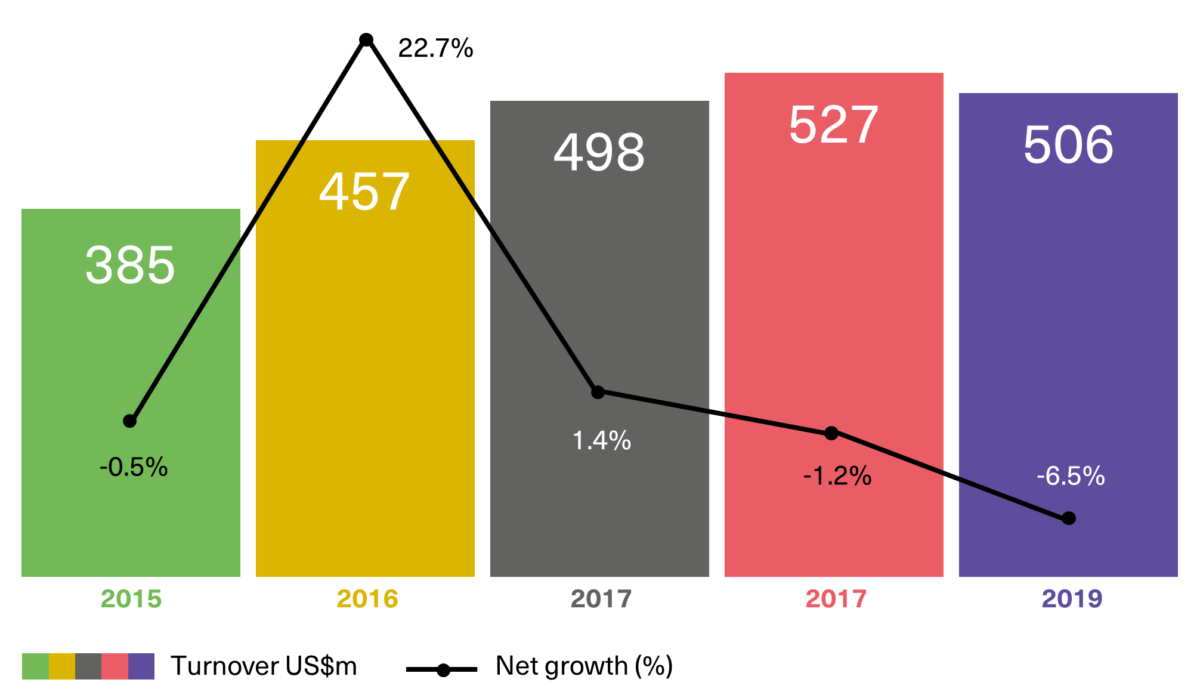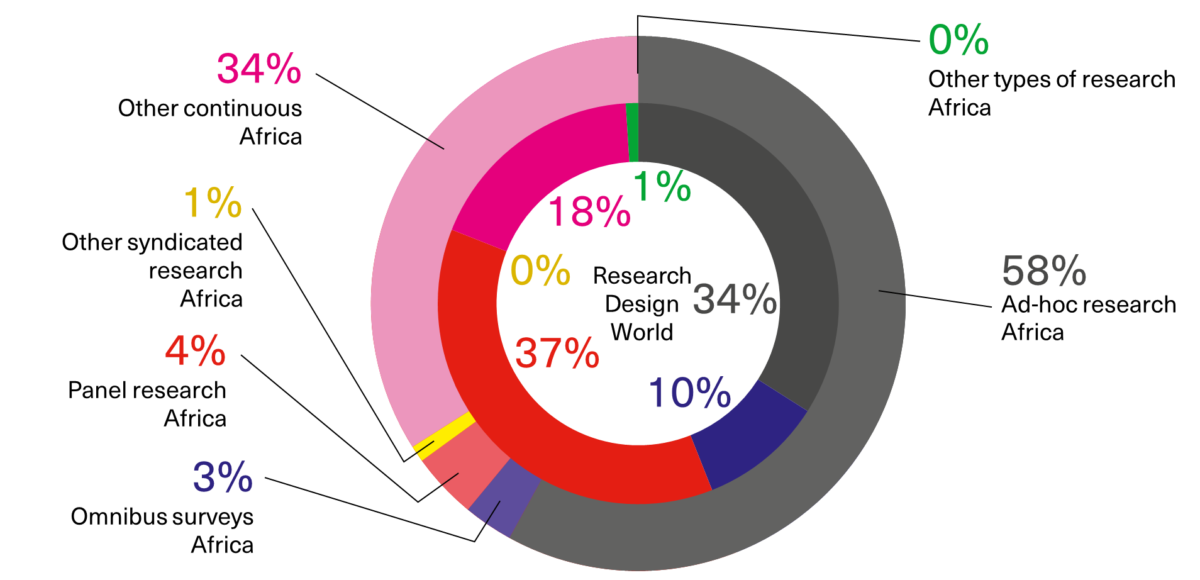ESOMAR invited selected voices from the African region to summarise the state of the Insights industry in each of the cardinal points of the continent. Their fascinating views present a dynamic and evolving market characterised by marked differences, the rise of methodologies aided by the increased adoption of technology, and the sliver of light that rose from the opportunities presented by the limitations of the pandemic. This is a snapshot of the African continent presented by renowned industry professionals Nermeen Bedeir, Dr. Jasper Grosskurth, Paul Nnanwobu and Major Tikiwa (more information on the contributors below).
North Africa: a push for agility and innovation
By Nermeen Bedeir
Across North Africa, quantitative research still prevails, making up about 75% of the research volume, where clients continue to make decisions supported by numbers. Qualitative continues to be key however, for the story behind the numbers and to strengthen the recommendations and client insights, more so post COVID-19 due to its diagnostic nature and the speed of delivery. In fact, in markets like Egypt for instance, Qualitative fieldwork was one of the fastest to transition to 100% online, where clients would be able to watch a live group being moderated online and even participate in the live discussion if needs be
Africa – Market research turnover as reported by the countries (2015 – 2019, US$ millions)

Source: ESOMAR’s Global Market Research 2020
In North Africa, clients are also increasingly asking for more speed and agility, now more than ever, when it comes to research design, project launch and delivery of results. That is where mobile and online surveys play a huge role and where agencies across North Africa now strive to develop their inhouse mobile and online panels increasing the needed capabilities to deliver on these platforms.
With the rise of internet and smartphone penetration, the increasing use of 4G and the predominantly youthful populations, no doubt that 2020 and beyond will witness a rising increase in mobile research. With that, will come less and less dependence on face to face research and the need for shorter, crisper and stronger questionnaires, with the LOI (length of interview) not exceeding 15 minutes and where skeleton questions are only asked to assess genuine consumer behaviour and sentiment.
An achievement and a mindset change in the North African research industry is the increased move to mobile/online methodologies, with shorter questionnaires, transitioning away from the usual lengthy 30+ minute interviews.
East Africa: surviving the pandemic through indirect research
By Dr. Jasper Grosskurth
Before, during and after Covid-19
Market Research in East Africa is in transition. Going into COVID-19, East Africa had one of the highest shares of spending on face to face interviews in the world. Many respondents still do not have a phone, or internet. Therefore, research of reasonable quality which is of relevance to the entire population still requires personal data collection (CAPI). This comes at a steep financial cost – and consequentially low industry growth. This combination of a high reliance on CAPI combined with high costs has made the East African market research industry exceptionally vulnerable to the negative impact of COVID-19.
Industry players who had built their models around remote data collection (SMS, online) have found their niche, their quality and their market growing steadily. A flurry of innovation and adaptation during the months following March 2020 has made that space more competitive and accepted. The innovations are not limited to new ways of collecting primary data.
Many innovations increased the use and analysis of existing data, of remotely collected data, of previously less visible databases in public and private hands: Facebook’s, Google’s and Uber’s mobility data, satellite based information on agricultural productivity, estimation models based on the extensive datasets of the National Bureaus of Statistics, or the ticket sales of bus operators, Wi-Fi providers, retailers, manufacturers and so on was used to derive relevant insights, all complemented by a flurry of surveys wherever possible.
Expectations on the performance of selected markets of the African Insights industry during 2020
| Country | Turnover 2019 | Actual 2020 expectation | 2020 expectation without COVID-19 crisis | Recovery by | |||
|---|---|---|---|---|---|---|---|
| US$m | % | US$m | % | US$m | Quarter… | …of… | |
| Nigeria | 109 | -5.0 | 104 | 3.0 | 112 | Q1 | 2021 |
| Kenya | 35 | -10.2 | 32 | 8.7 | 38 | Q4 | 2020 |
| Ghana | 16 | 10.0 | 18 | 5.0 | 17 | Q1 | 2021 |
| Tunisia | 6.1 | -20.0 | 4.9 | 20.0 | 7.3 | Q4 | 2022 |
| Zimbabwe | 2.7 | -15.0 | 2.3 | 4.0 | 2.8 | – | – |
| Sudan | 0.4 | -30.0 | 0.3 | -20.0 | 0.3 | Q2 | 2021 |
| Africa | 506 | -5.4 | 479 | 5.0 | 531 | – | – |
| World* | 72,984 | -25.3 | 54,523 | 3.9 | 75,824 | – | – |
| * Global turnover is the aggregated estimate provided by each country. The 2020 Global Market Research report, however, identifies an unreported amount that brings this figure to almost US$ 90 billion. | |||||||
Source: ESOMAR’s Global Market Research 2020
Coming out of this crisis, we can expect i) a further commercialisation of data collection in the field by well-trained freelancers without any overhead cost resulting in pressure on overall margins; ii) a significant wave of new data collection channels, many of them specific to an industry, a target population, or a purpose; iii) a more integrated research approach that comprehensively combines freshly collected primary data and different types of secondary data.
Overall, the region has come through 2020 remarkably well. The Marketing and Social Research Association has played an important role in co-ordinating the more established industry players throughout the crisis. 2021 is a period of many uncertainties and many opportunities.
West and Central Africa: a new opportunity for a nascent region
By Paul Nnanwobu
The West African sub region, with an estimated population of 402 million, is a complex geography of the African continent. Because language plays a dominant role in international research, it is very important to understand the languages and cultural diversity of the region. As an example, today Africa is the continent with the largest number of French speakers in the world, while English-speaking Nigeria is the largest black nation in the world with over 200 million amalgamated people. Overall, Nigeria, Senegal, Ghana, Cote D’Ivoire, DRC control over 90% of total research done in West and Central Africa (WECA) region.
Recently, the advent of mobile telephony (especially GSM around 2001) in most WECA countries, opened a new horizon in technological research methods and this began the gradual elimination of PAPI methods. Although today face to face methods still account for almost 70% of the research, there have been some in-roads in the use of CAPI and CATI (currently gaining momentum), TI, CAWI, text and online Panels– which has been less successful due to infrastructural under-development.
In terms of workforce, the rising young population in the WECA sub region, where more than 64% are under the age of 24 years, represent a tremendous resource – but their potential will only be realized when the right investment in their education, health, skills and empowerment are made. Market research has great potential to have profitable development when this labour force is harnessed and trained for development.
Spend by research method – breakdown of quantitative and qualitative methods in Africa, 2019 (%)

Source: ESOMAR’s Global Market Research 2020
With the rising use of mobile technology from 2010, the proliferation of computers and the emergence of internet services, mix methodologies began to emerge to the point of displacing F2F almost completely. However, nowadays face to face CAPI/ MAPI (Mobile Aided Personal Interview) remains the most reliable methodology in WECA.
Text methodology, (using SMS) is now becoming popular, despite the high rate of attrition. All in all, quantitative methodologies account for 80% of total research turnover in the region while qualitative methodologies (15-20%) focuses on in-person and (now emerging) online focus groups, IDIs and ethnography. Many domestic companies are facing up to the new challenges by upgrading their offer with new technologies to avoid being left behind. Methodologies such as online panels are coming up, though with strong challenges, and represents less than 1% of the research method usage.
Despite the moderate impact of the pandemic, businesses were paralyzed – especially during the practically unsustainable lockdowns. The region was hard hit because of its over reliance on Face to Face methodology. However, the pandemic has awakened the imperativeness of research suppliers in the region to adopt new technologies to remain relevant. The ‘new normal’ also ushered in a different kind of attitudinal change in the workspace. Most people have become increasingly health conscious amid increased concern over work environment wellbeing.
Southern Africa: the multiple features of a maturing region
By Major Tikiwa
There are notable disparities between the leading South Africa market and its neighbours, Zimbabwe, Mozambique, Botswana, Namibia, Zambia, Malawi, Angola, Swaziland and Lesotho. However, Southern Africa has seen an overall slower growth in the market research and insights industry over the last decade, given the limited research commissioned by companies.
While Southern African countries have experienced local companies that operate as boutiques and offer good services, they are hindered by limited local budgets and the monopoly of multinationals over international budgets and Joint Industry Committee (JIC) type of surveys. Global agencies are, thus, extending their global mandate on a small scale as they work with local agencies.
High profile respondents, with access to internet and smart phones, have grown tremendously to the point of now nearly on par with global counterparts and are able to complete online surveys successfully. Business to business research, however, is limited and the value of research as a catalyst for development is negligible affecting the African progress in all economic and political spheres.
Increased mobile access has boosted field possibilities and is powering telephone interviewing. Mobile research has helped overcome physical travel barriers making shorter surveys possible. Face to face was the most common research methodology in the region, now using tablets instead of pen and paper. Mobile (now with increased reach including poorer communities), online (for business and high end, mystery shopping for services especially), observation, focus groups (including virtual groups), or in-depth interviews, have all become virtual as well.
Estimated spend by research design in Africa compared to the rest of the world, 2019 (%)

Source: ESOMAR’s Global Market Research 2020
Southern Africa has a well-educated workforce that requires continuous training as few universities are offering a degree in market research – market research is generally offered as a module in most business degrees. Sector education training is also improving with Southern African Marketing Research Organisation (SAMRA), the Pan African Media Research Organisation (PAMRO) and ESOMAR taking the lead on Industry matters to ensure professionalism amongst researchers, sharing ideas and new developments.
Since Southern Africa is composed of many unique markets, broader studies should ensure their sample sizes are large enough to compare results by country, region, or demographic group with methodologies that best suit their project and the population they are trying to reach. Projects with higher budgets and those looking to reach rural or illiterate populations may be better suited to an in-person method such as CAPI or voice call method such as CATI. Those with lower budgets may choose to conduct research via SMS or online through web-based links. Focus groups administered either in-person or through online or mobile-based focus groups may also be appropriate for certain projects.
Lastly, the COVID-19 pandemic devastated most companies. Changes included diminished investment and spend on market research, an increased virtual meeting phenomenon and its use for qualitative research. These also offered opportunities for reduced operating costs.
Africa calls for more accurate and reliable market research data for the universal and local corporations moving to understand their specific markets and audiences.



1 comment
A well articulated report. I am enlightened by the report.